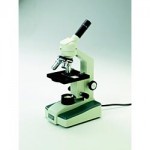So I’ve been looking at what we can do to replace or repair our broken-down microscopes. We have about 20 Boreal Skopes compound microscopes about nine of which are still working well. Asking around about who can fix them I learned that there are no microscope repair people anywhere in the peninsula (the North Olympic Peninsula). When I starting searching for repair places the top results were places in New York, Michigan, Wisconsin, etc. I did find one place in CA that sounded good but then I focused my search to WA State because maybe there were other repair places closer to us. Not very promising. I found one place that sounded perfect, Bohrers Microscope Repair, so I called. The Bohrer guy used to fix microscopes up in Bellingham for middle schools up there and for WWU but he’s been retired for a while. We talked for a long time.
Basically, the Bohrer guy told me that our problem is widespread. There are few people who learn how to repair microscopes and those that do have to charge quite a bit to be able to earn a living. Basically, a guy like him would charge us mileage to drive over here, then depending on what we have and how many we have, in our case about 20 scopes, he would charge either $20 to $30 per scope or $100/hr. In other words, he’d have to earn a day’s work to bother even coming over here. Shipping the scopes is an option but with prices so low, as low as $100 per scope (even a digital scope), it might be better to buy cheap scopes and canabalize the older ones for parts. See knowing how to fix microscopes is only part of the problem. Even if you can fix microscopes parts are hard to come by. No parts means you can’t fix the scopes even if you know how.
The Bohrer guy also said many schools, even universities, don’t really teach microscope basics anymore because there’s so much digitally (esp YouTube). In college courses he said they just jump in to genetics and looking at organelles so they don’t bother with low power scopes. He was thinking we might need to change our curriculum once we don’t have enough scopes. That seemed like a shame to me. We’re not giving up on our scopes. Even with YouTube and great animations showing the worlds inside cells, nothing beats seeing actual microorganisms on your very own slide.
So I called the National Microscope Exchange and that guy is still in business. He’s not traveling anymore and doesn’t really do schools because he’s working mostly on high end medical opticals. Still, he gave me his URL, https://www.nationalmicroscope.com/, and he said that if we mail him a scope he’d look at it and let us know if there are even parts for it. What he’ll do is give us an idea of whether we should pursue fixing ours or buying new ones. I told him that we have 20 scopes and he said that even shipping them to him will get pricey. What he would do with them if there are no parts is take like five of them and use the parts to fix the other 15 (15 would do well in a class of 30). But I don’t know how much that would cost to ship. What both guys warned me about was buying cheap scopes. Sure, we could buy five $100 scopes now and five later but they would die sooner than good ones and they’d be garbage because cheap scopes come from companies that don’t make the parts anymore so they can’t be repaired.
The guy from National said he prefers and sells (even though we could get them from anywhere we want) Vee Gee scopes, http://veegee.thomasnet.com/category/educational-microscopes, because they continue to make the parts. If we had money, they’d be the place to go.
I still looked around for cheap scopes, aside from Boreal, Carolina, and the other we normally use, and I found this site with what looks like great deals on microscopes like ours:
and this one:
 A Boreal Skope, like the one pictured here, are the ones we use and start at $250. With our budget the way it is we cannot afford to buy many of these. Do we buy two of these, if they can be repaired that is, or go with five $100 models and just throw them out when they break down?
A Boreal Skope, like the one pictured here, are the ones we use and start at $250. With our budget the way it is we cannot afford to buy many of these. Do we buy two of these, if they can be repaired that is, or go with five $100 models and just throw them out when they break down?
 Since I have ten iMacs in my classroom I also have access to ten of these Digital Blue Microscopes. I have to admit that I really do like these scopes and the kids do too. They are easy to share because it projects on the computer screen so kids don’t have to take turns. Digital scopes also allow kids to take photos and videos of what they are seeing. That is a huge bonus especially for blogging. Downside? While things look great at 10x and 60x magnification, the scopes don’t show much at the 200x setting. It requires much more light so if we shine a flashlight we can see a bit better. The non-digital scopes easily work at 100x and 400x magnifications. So I need both to offer my students the best microscopy learning and viewing experience.
Since I have ten iMacs in my classroom I also have access to ten of these Digital Blue Microscopes. I have to admit that I really do like these scopes and the kids do too. They are easy to share because it projects on the computer screen so kids don’t have to take turns. Digital scopes also allow kids to take photos and videos of what they are seeing. That is a huge bonus especially for blogging. Downside? While things look great at 10x and 60x magnification, the scopes don’t show much at the 200x setting. It requires much more light so if we shine a flashlight we can see a bit better. The non-digital scopes easily work at 100x and 400x magnifications. So I need both to offer my students the best microscopy learning and viewing experience.
Bottom line is that if we buy $100 scopes, we’ll be buying them forever. If we buy $300 or $400 scopes they will last and can be repaired. But the question is how long will National keep repairing scopes? And will there be more repair places after them? Buying cheap might be the way to go (disposable microscopes!?). And then there’s the digital option. Could we get better digital scopes for $300 or $400? I haven’t researched those. I’m afraid I’d find something that we could really use but can’t afford. What are your experiences with microscopes?



















































